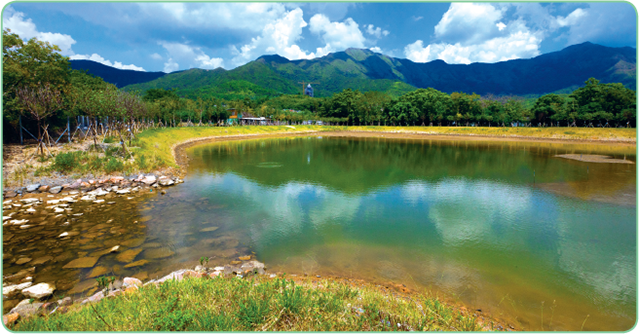
Sustainability is Our Priority
In face of population growth, progress and development are inevitable. At the same time, due diligence has to be exercised to preserve the environment. In 2011-12, we continued to act responsibly with an aim to make certain that not only our generation but the next and the following generations are assured of a sustainable and comfortable living. Our team makes long-term planning with green economy in mind (i.e. economy that results in improved human well-being and social equity, while significantly reducing environmental risks and ecological scarcities.)
In the year, we planted more trees and shrubs and added more green elements to our various sewage treatment works (STWs) and drainage facilities. Among our ambitious projects is the improvement works at the Kai Tak River. Works are being carried out to enhance the river's flow capacity and at the same time also the river's ecology with an aim to turn it into both a habitat for fish and other aquatic organisms and also a visually-pleasing area for public recreation. Do read about the details in the inside contents.
Carbon reduction, resource conservation and achieving high energy efficiency are areas of great concern and our primary objectives. We are ceaselessly widening the use of electric vehicles to replace the traditional fossil fuel cars, actively promoting solar energy and wind energy, and doing our utmost to retrieve and transform the biogas generated from our sludge treatment process to electricity for use in our STWs. Also, we are taking a further step to treat wastewater so that it can be reused. We remain watchful of the greenhouse gas generated from our treatment works and drainage projects through our carbon auditing exercise, and have set our target to generate 33 million kWh of electricity by 2013 (equivalent to one year of electricity consumption by 5000 four-member families) from the total volume of biogas produced by these facilities. Our Department is also installing a greater number of combined heat and power generators at the STWs — which will undoubtedly improve energy efficiency. In brief, a green economy remains our Department's commitment and we will continue to do our best to reach relevant targets.
Hong Kong is severely deficient when it comes to land resources. To match the Government's sustainable development policy, this Department will carry out a feasibility study on the relocation of Shatin STW to rock caverns. This will not only free up 28 hectares of government land for other uses that will benefit residents' livelihood but will also be beneficial to both the community and the environment in the long-term. A feasibility study will soon commence with the aim to formulate the most cost-effective relocation proposal.
While on the topic of sustainability, I would like to express my gratitude to the commendation and recognition from players within the industry towards our works in environmental protection. Our colleagues' creativity in this area has yielded notable results. Our paper, titled '3+1 Approach', based on the innovative greening initiatives and our experience at Shatin STW, was awarded the first prize in the 'Civil Engineering Paper of the Year Award 2011' presented by the Civil Division of the Hong Kong Institution of Engineers. This surely affirms our Department's efforts and contribution in promoting greening in works projects. Moreover, our pro-active implementation of greening works, including research in green roofing and vertical greening over the years, has not only beautified our facilities but also the surrounding neighbourhood. Such efforts have also won recognition from green groups, the district councils and the neighbourhood committees, which we find encouraging.
Treating Wastewater
Treating wastewater is one of our Department's core businesses. It is also an area of work that is closely associated with the everyday lives of Hong Kong people. Therefore, our entire team takes it as their vision to provide a world-class sewage treatment service to our general public. With advanced wastewater treatment technology, we have removed substantial amount of pollutants from wastewater.
To cope with the ever-increasing population growth and residents' rising expectations on cleanliness and hygiene, we have devoted more resources to sewage treatment. Up to the current fiscal year, we have built for Hong Kong a sewerage network that measures 1647 kilometres in length, serving 93 per cent of Hong Kong's population. The volume of treated sewage amounts to 981 million m3. To handle this massive volume of sewage, we have also increased the number of our STWs and sewage pumping stations to 287, spreading across the territory.
In a bid to continue to improve water quality and hygienic condition in the rural areas, we need to ceaselessly extend our public sewerage system to more villages. Works in this regard have been progressing satisfactorily. In addition, we will need to raise the capacity of the sewage treatment facilities downstream at the appropriate times to ensure that they can cope with the extension works on the sewerage system, developments in the communities and population growth.
In 2011-12, we have started the improvement works at Mui Wo, Cheung Chau and Tai O STWs and pressed ahead other on-going improvement works at Stonecutters Island, Pillar Point, Tai Po and Shatin STWs.
Through implementation of these works, we wish to provide sewage treatment service with a higher standard to Hong Kong people, and to improve their living environment.
Preventing Floods
In the area of flood prevention, our drainage projects spread throughout Hong Kong. The projects under design and construction will cost some $24 billion. With unwavering spirit and the employment of advanced technical know-how, we have overcome various difficulties during implementation of our projects promptly. As in the past, we review and update our drainage master plans on an on-going basis so as to cope with Hong Kong's ever-changing needs in this regard.
In this fiscal year, different stormwater drainage improvement projects have been progressing smoothly. Among them, the Hong Kong West Drainage Tunnel and the Lai Chi Kok Drainage Tunnel will be commissioned in the second half of 2012. The projects will substantially improve the flood protection level of northern Hong Kong Island and western Kowloon. We are also pleased to learn that the Hong Kong West Drainage Tunnel has won the International Tunneling Award and was commended by the judging panel as 'a model tunnelling project'. Details can be found in this report's 'Highlights of the Year' chapter.
In addition, 2012 marks the 30th anniversary of Hong Kong's co-operation with Shenzhen in the Shenzhen River Regulation Project. With hard work from both sides, the first three stages of the river regulation works have been completed and have solved the flooding problems that used to hit both Hong Kong and Shenzhen. In order to tie in with the development, Stage IV of the project will further enhance the flood protection levels of the upstream section of the river as well as the Liantang/Heung Yuen Wai Boundary Control Point area. The design of Stage IV, which has adopted an ecological river concept with rehabilitation and conservation of the existing ecosystem as key considerations, was already underway. The works are scheduled to complete in 2017. The flood protection level of this river section will be upgraded to withstand rainstorms with a 50-year return period, safeguarding the livelihood of residents in both cities from flooding.

Looking Forward
As we get through another year, and as we take stock of what have been accomplished, we are confident that much of our hard work and long-term planning will start to bear fruits within the next few years. The livelihood of citizens will thus be improved. Soon to be activated is our 'Total Asset Management Scheme'. In July 2012, we will commission a survey on our underground sewers and drains, to investigate their operating condition. We expect to have a solid knowledge of the actual situation of our assets upon completion of the survey and will thus be able to formulate management plans as well as rehabilitation and replacement strategies for our drainage networks. All of these will enable us to have a more systematic approach in allocating resources. Overall, this will enhance our drainage facilities' reliability.
On flood prevention, we are reaching a new milestone with the signing of an agreement for the major works of the Happy Valley Underground Stormwater Storage Scheme by the end of this summer. This $1-billion scheme, the biggest New Engineering Contract ever to be awarded by the Government, will incorporate innovative and eco-friendly features. When completed in early 2018, the scheme, with a built-in automated monitoring system, will be capable of diverting the stormwater flow from upstream drainage to the storage tank effectively. The diversion will substantially reduce stormwater runoff to the existing downstream drainage system, thereby alleviating flooding risk in Happy Valley and Wanchai districts.
On sewage treatment, the on-going project, Harbour Area Treatment Scheme Stage 2A, is progressing smoothly, and is expected to become operational in the fiscal year 2014-15.
We are fully aware of the mounting challenges that are heading our way in the coming days; but we firmly believe that with determination, we will be able to deliver our promises and assure Hong Kong people an even cleaner, safer and better living environment.
